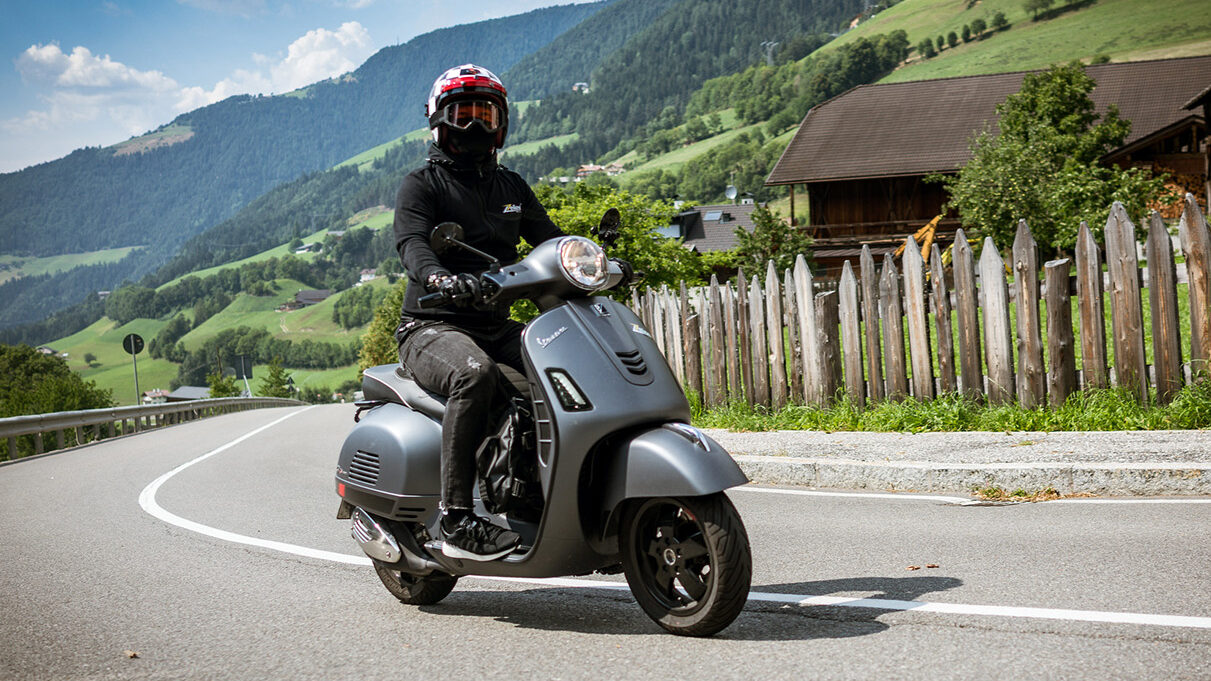Anyone who says that we can’t ride our Vespa in the fall and winter is making a mistake in thinking. Sure, it’s cold. And it’s wet, slippery and often frozen on the roads. So we prefer to leave our scooter in the garage. But no, we only do that in extreme emergencies!
In the garage, the Vespa might get a flat tire and we risk flash rust. We would have to mothball the vehicle. Everyone can protect himself against the cold. In any case, every scooter driver can better protect himself against the cold than against the sweltering heat in the summer. In the moderate weather conditions that we have been experiencing for years in winter, it is quite possible to ride a Vespa. But there are some things that need to be taken into account, not only for our comfort, but also for road safety.
What can be dangerous on the road in autumn/winter?
- Frost, cold, difficult road conditions
- low sun that blinds us
- fog, which impairs visibility
- on country roads and farm tracks contaminated with dirt and grime from agricultural vehicles, a slippery road surface can form
- crop residues such as fallen fruit etc. are also to be expected
- coupled with moisture and humidity, this results in an extremely dangerous smeary film on the road surface (this is referred to as farm slick in some areas)
How can we arm ourselves against such hazards?
In the first place, get off the gas. Braking gently will minimize the risk of skidding, especially when accelerating out of curves. Even if slower vehicles tempt, do not make excessive steering maneuvers. It is difficult to see what the road conditions are ahead of the next vehicle and there may always be a hidden danger.
In general, accelerate carefully to minimize unexpected tire slippage. Overall, the lower the speed, the less braking is required. The condition of the asphalt should always be kept in mind, especially for unfamiliar trails. For completely unfamiliar routes, it can be worthwhile to check the area surrounding the route in advance on Google Maps. On asphalt with low roughness, the Vespa can also slip away more quickly, since the tires can find less grip on the ground.
What must be paid special attention to in the fall?
Especially on and under bridges it can often become quite slippery or icy at low temperatures. Also, early in the morning and late in the evening, the ground can freeze more quickly and take drivers by surprise. Generally, one speaks of winter slippery already from about 4 ° Celsius in the plus range and is underestimated by many. It must always be remembered that our good old Vespa has no standard sensors that warn of cold and black ice. Therefore, make inquiries at the weather service before the trip about the current weather situation and how it develops during the day.

What do we need to consider in technical terms?
The tire tread is very important:
The prescribed tread depth is at least 1.6 millimeters, and we recommend a minimum tread depth of 4 millimeters in cold weather. When it comes to this, the police measure the tire tread at a point that has the lowest tread, i.e. in the middle of the tire.
How do I determine the tread depth of my tires myself?
A 2-euro coin whose silver edge has a depth of 4 mm is suitable for this purpose. If this edge does not look out of the tread groove of the tire at the top, we still have the recommended tread depth of 4 mm. Alternatively, a 1-euro coin can be used. Its golden edge has a depth of 3 mm.
For the right choice, there is a wide range of tires by type, in which all Vespa owners will certainly find and be happy.
Clothing is the be-all and end-all:
Put on warm and weatherproof clothing, starting with underwear and ending with outerwear. Smart people swear by the onion principle, so rather put on several layers on top of each other than a single thick piece. Protective gloves, which not only keep out the cold, but also protect against abrasions in the event of a fall, for example. Good and functional clothing is undoubtedly a matter of willingness to invest.
What maintenance is due in the fall and before winter?
We distinguish between DIY and inspection at a specialist dealer. If we carry out the work ourselves, we save a lot of money, but we need manual skills, the necessary time and the right tools for care and maintenance.
Here we assume that we are capable of doing the work ourselves:
- First, we clean and clean our scooter thoroughly. Not only for the sake of cleanliness, but also to locate and repair any damage to the paintwork before it becomes more serious.
- Using a box wrench, we loosen the drain plug of the oil tank and catch the oil in a suitable container. Once the used oil has completely drained out, screw the drain plug back in.
- When we find the filler plug for the engine oil, usually marked with a color, we unscrew it and fill the oil tank with new oil up to the filling mark (maximum).
- Then we inspect the air filter by removing the filter element from the housing (usually made of plastic). Ideally, we use a compressor to clean the filter (coarse dirt particles), which we knocked out beforehand.
- Then we check the spark plug(s) for their suitability. In case of heavy wear/sooting, replace directly.
- We carefully check the condition of the brake system, possibly the play of the brake levers must be readjusted.
- The air pressure and the tire profile must be checked.(see above)
- The light system/indicators should be checked for their function, so that the Vespa is not overlooked in dark times and fog.
- Finally, we check all screws for tightness and condition.
Important notice:
The more careful and comprehensive the inspection in the fall is with regard to the upcoming winter, the less needs to be done during the spring check.
For safety reasons, anyone who is not confident enough to carry out the work themselves should entrust their vehicle to a workshop.
With this in mind: Have a good trip, even (or even more so) in the cold season!


